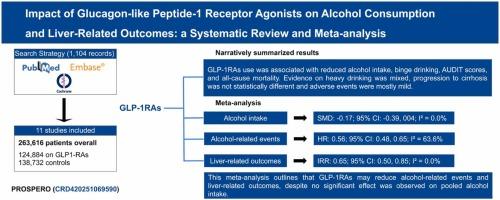Impact of glucagon-like peptide-1 receptor agonists on alcohol consumption and liver-related outcomes: A systematic review and meta-analysis
IF 3.6
2区 医学
Q1 PSYCHIATRY
引用次数: 0
Abstract
Background
Glucagon-like peptide-1 receptor agonists (GLP-1RAs) have demonstrated potential in reducing alcohol intake and impacting liver-related outcomes, mostly in patients with alcohol use disorder (AUD). This systematic review and meta-analysis aimed to further assess this association based on current evidence.
Methods
A comprehensive search of PubMed, Embase, and CENTRAL was performed in May 2025. Random-effects meta-analyses or narrative synthesis were conducted depending on data availability. The pooled effect size was standardized mean difference (SMD), incidence rate ratio (IRR) or hazard ratio (HR) with 95 % confidence intervals (95 % CI).
Findings
Eleven studies (3 RCTs, 8 observational) including 263,616 patients (124,884 on GLP-1RAs, 138,732 controls) were included; 8 provided sufficient data for meta-analysis. In narratively summarized results, GLP-1RAs use was associated with reduced alcohol intake, binge drinking, AUDIT scores, and all-cause mortality. Evidence on heavy drinking was mixed, progression to cirrhosis was not statistically different and adverse events were mostly mild. In the pooled analysis of alcohol intake, no significant difference was observed with GLP-1RAs use (SMD −0.17; 95 % CI: −0.39, 0.04; I² = 0.0 %). However, GLP-1RAs use was associated with reduced alcohol-related events (HR 0.56; 95 % CI: 0.48, 0.65; I² = 63.6 %) and reduced liver-related outcomes (IRR 0.65; 95 % CI: 0.50, 0.85; I² = 0.0 %).
Conclusions
This meta-analysis outlines that GLP-1RAs may reduce alcohol-related events and liver-related outcomes, despite no significant effect was observed on pooled alcohol intake. Further high-quality studies are warranted to establish the efficacy of GLP1-RAs in reducing alcohol use and mitigating liver injury.

胰高血糖素样肽-1受体激动剂对酒精消耗和肝脏相关结果的影响:一项系统综述和荟萃分析
胰高血糖素样肽-1受体激动剂(GLP-1RAs)已被证明具有减少酒精摄入量和影响肝脏相关预后的潜力,主要用于酒精使用障碍(AUD)患者。本系统综述和荟萃分析旨在基于现有证据进一步评估这种关联。方法于2025年5月综合检索PubMed、Embase和CENTRAL。随机效应荟萃分析或叙事综合根据数据的可用性。合并效应大小为标准化平均差(SMD)、发病率比(IRR)或风险比(HR), 95%置信区间(95% CI)。结果:纳入6项研究(3项随机对照试验,8项观察性研究),包括263,616例患者(124,884例GLP-1RAs治疗,138,732例对照);8提供了足够的数据进行meta分析。在叙事性总结的结果中,GLP-1RAs的使用与减少酒精摄入量、酗酒、审计评分和全因死亡率有关。重度饮酒的证据是混合的,进展到肝硬化没有统计学上的差异,不良事件大多是轻微的。在酒精摄入的汇总分析中,GLP-1RAs的使用没有观察到显著差异(SMD: - 0.17; 95% CI: - 0.39, 0.04; I²= 0.0%)。然而,GLP-1RAs的使用与减少酒精相关事件(HR 0.56; 95% CI: 0.48, 0.65; I²= 63.6%)和减少肝脏相关结果(IRR 0.65; 95% CI: 0.50, 0.85; I²= 0.0%)相关。本荟萃分析概述了GLP-1RAs可能减少酒精相关事件和肝脏相关结果,尽管没有观察到对合并酒精摄入量的显著影响。需要进一步的高质量研究来确定GLP1-RAs在减少酒精使用和减轻肝损伤方面的功效。
本文章由计算机程序翻译,如有差异,请以英文原文为准。
求助全文
约1分钟内获得全文
求助全文
来源期刊

Drug and alcohol dependence
医学-精神病学
CiteScore
7.40
自引率
7.10%
发文量
409
审稿时长
41 days
期刊介绍:
Drug and Alcohol Dependence is an international journal devoted to publishing original research, scholarly reviews, commentaries, and policy analyses in the area of drug, alcohol and tobacco use and dependence. Articles range from studies of the chemistry of substances of abuse, their actions at molecular and cellular sites, in vitro and in vivo investigations of their biochemical, pharmacological and behavioural actions, laboratory-based and clinical research in humans, substance abuse treatment and prevention research, and studies employing methods from epidemiology, sociology, and economics.
 求助内容:
求助内容: 应助结果提醒方式:
应助结果提醒方式:


